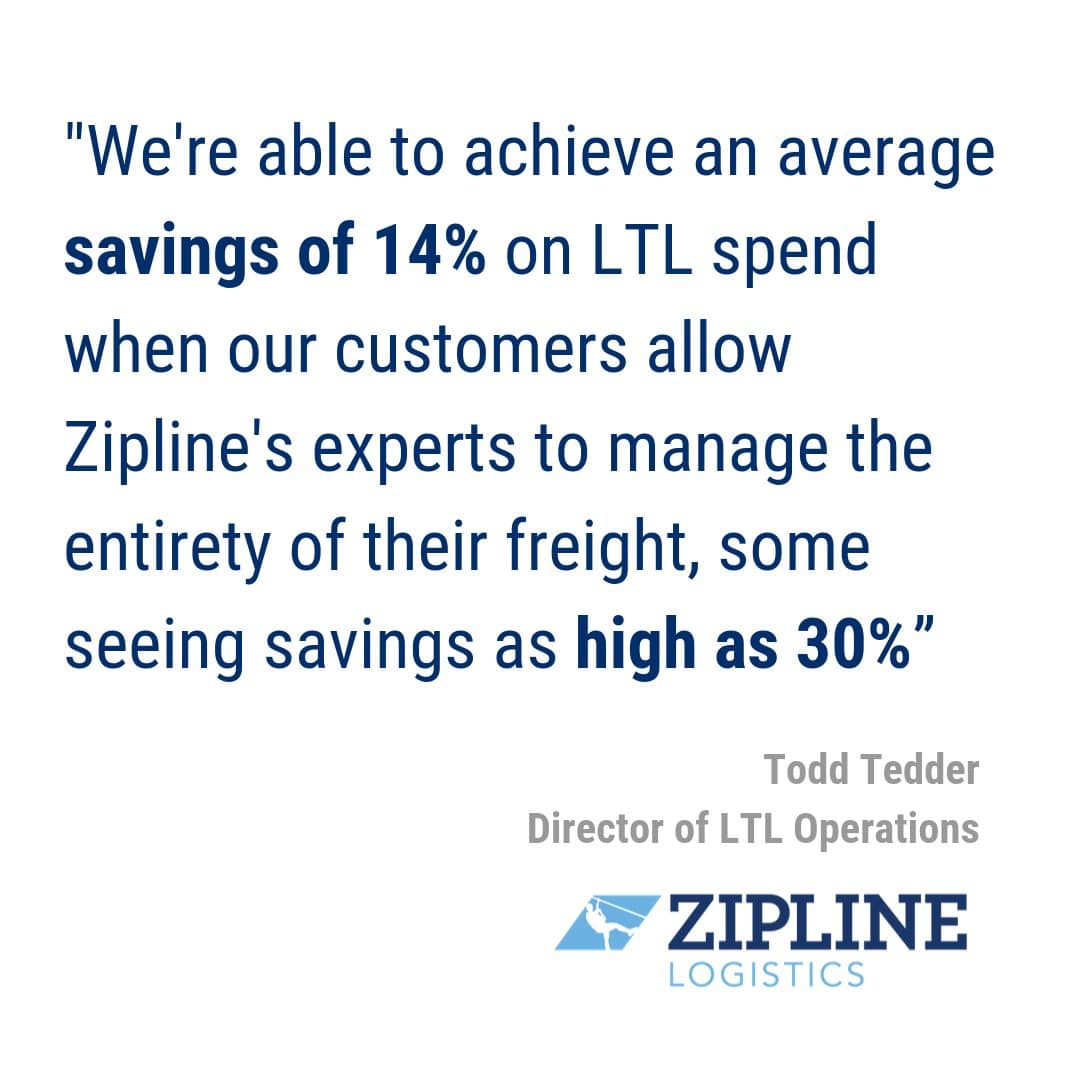
Though it may seem counterintuitive, booking the cheapest truck does not always equate to LTL freight savings.
Continually chasing rates and opting for the lowest cost provider can be a short-sighted approach to your logistics strategy.
While in the immediacy you can see minimal LTL freight savings with this tactic, there are often unforeseen, added costs that negate any perceived benefits.
Instead, you can achieve widespread and scalable transportation savings if you chose to establish a partnership with your transportation provider.
How Does a Logistics Partner Lead to LTL Freight Savings? 
Rather than continually requesting quotes and choosing the lowest cost provider, forging a logistics partnership means you will be working strategically with a minimal number of providers to establish volume discounts or account specific pricing agreements.
“We’re able to achieve an average savings of 14% on LTL spend when our customers allow Zipline’s experts to manage the entirety of their freight, with some shippers seeing aggregate savings as high as 30%,” explains Zipline’s Director of LTL Operations, Todd Tedder.
The benefits associated with having a true logistics partner extend beyond concrete LTL freight savings. A partner will care more about the successful delivery of your orders, can provide more visibility into your costs and performance, and offer counsel on route and order optimization.
What is LTL Account Specific Pricing?
Customer specific pricing, or account specific pricing, refers to an agreement between a vendor moving product and a carrier or 3PL that establishes custom prices. Shippers who move volume above a certain threshold are eligible for a discounted rate because they give the carrier guaranteed business.
Much like firms in other industries, freight carriers will offer business a lower price per transaction for “buying in bulk.”
As part of the agreement, the customer accepts using a certain carrier, or group of carriers, for the agreed upon freight moves. In turn, the customer receives favorable pricing over the carrier’s typical rate.
This benefit cannot be achieved by opting for the lowest cost provider on each of your shipments, working the spot market.
So, How Do I Receive LTL Account Specific Pricing?
In order to unlock your full potential, you need to abandon alluring short-term LTL freight savings in favor of a long-term refined transportation strategy.
To receive customer specific pricing, you must build strong relationships with a core group of carriers; however, you can circumvent some of this groundwork by working with a 3PL. By enlisting the help of a dedicated logistics partner, you can leverage freight broker rate negotiations to see LTL freight savings that are significantly lower than the pricing available to you directly through a carrier.
Because a 3PL moves freight for many vendors, they are privy to more favorable pricing with carriers at the national level vs. the local level that most shippers have relationships with. Those savings can be passed directly to you.
Get Strategic About Your Freight for Scalable LTL Freight Savings
Shippers looking to truly cut costs over the long-term can benefit from a more refined approach to their transportation.
While leveraging the spot market is not completely avoidable, asking for new rates on each shipment should not be your main savings strategy.
While it is true that booking a truck on the spot market can translate into a lower upfront spend, the unforeseen costs that accompany a low-cost provider can be substantial.
Think of that low spot market price as just the baseline cost.
There are some instances in which that rate will be reflective of your total; however, more often, other fees and impacts will be tacked on.
Even more than just the immediate cost of a shipment, there are other negative effects on your organization that can come with a transactional approach to transportation.
Issues Compounded by Transactional Logistics
Without establishing a working relationship with a dedicated logistics partner and by working on a transactional basis with carriers, you are setting yourself up for issues. Delivery service failures can create a domino effect that reverberates throughout the rest of your supply chain and subsequently, your organization. Here are some common issues we see from shippers who approach freight as transactional:
Service Failures
Service failures are common with low cost carriers. They are coordinating their network based on profitability, not what is best for you. Without an established partnership, they are unlikely to offer up solutions if something goes wrong and problems end up back in your court to decipher.
It’s likely you could experience a dropped shipment, unmatched expectations, and poor communication.
You facilitate this lower level of service when you jump between carriers for $20-$50 savings per order.
Savings Counsel
Transactional providers cannot see your entire freight network and therefore cannot make recommendations for consolidation or mode shifts. Without full visibility into your shipping schedule, they are just order takers.
When you award a partner the chance to see your full network, they can make strategic recommendations that help establish even more LTL freight savings.
LTL Timelines
When booking the lowest cost provider for big-box deliveries, you are not confirming that the carrier can deliver against your specific timeline.
LTL deliveries for retail customers can prove tricky. You may book an LTL carrier that says it can deliver in your time window.
But if you are going to an appointment-based facility, the LTL provider can’t book an appointment until your freight hits their closest terminal. Sometimes that appointment can’t be booked that same day and must be reserved a few days or weeks out.
So, that carrier may be able to get your freight to their terminal in the time window you demanded but may not be able to deliver against your customer’s due date because of appointment setting intricacies.
On top of storage fees that can be incurred as you wait for an appointment, you could be incurring retail chargebacks.
Worst of all, you could damage your retail relationships. And 73% of retail buyers report ending vendor relationships over delivery issues.
Is losing a retail customer worth that $50 perceived LTL freight savings?
Paying slightly more for a carrier that can guarantee retail deliveries and is a “preferred carrier” will save you more in the long run.
How Zipline Can Help You Manage Your Freight Savings
Booking the cheapest carrier is not worth the gamble for shippers working against strict deadlines or just-in-time schedules.
It is crucial to work with a logistics partner that understands the nuanced reality of LTL and retail shipping. A partner can help you avoid common shipping pitfalls and will always have your best interest at heart. They can build scalable cost programs on your behalf and transfer savings to you directly.
Zipline works with both emerging and established CPG brands to optimize their shipping programs and ensure both on-time delivery and cost savings. This is all made possible through transportation partnerships and transparency. Not through $10 savings per order.